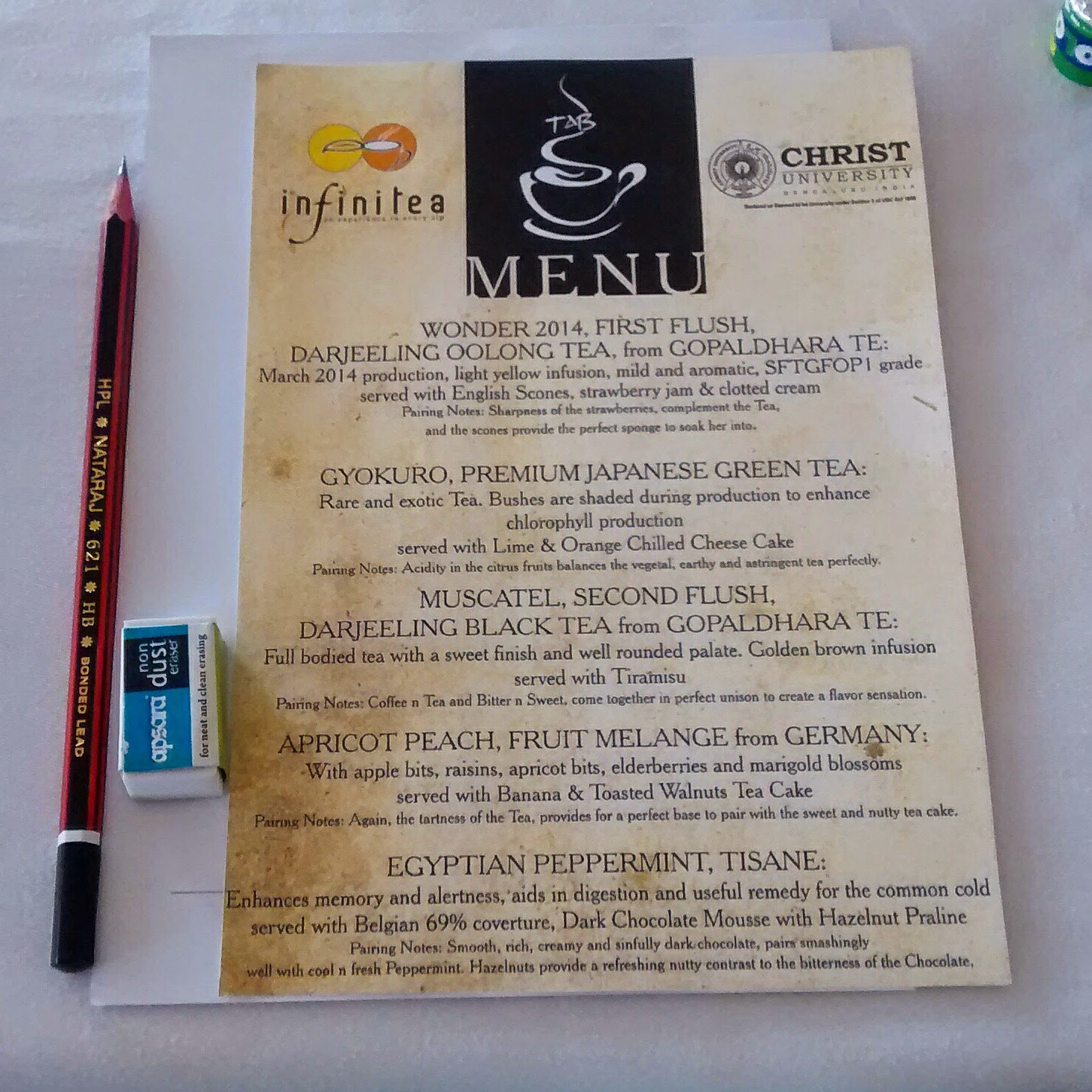Two and a Bud
This Saturday I attended a tea workshop held at the
university. It’s an annual workshop called Two and A Bud -- because tea is
always picked as the two most tender leaves and the central bud.
The workshop was conducted by Mr. Gaurav Saria, owner of Infinitea,
a popular Bangalore tea room. He is a tea man by family heritage. Each year the
workshop showcases five new teas that have done well that year.
This year, the workshop had a new format. Rather than simply
having tea tastings, we tasted five teas along with dessert pairings.
 |
| The Menu |
 |
| Wonder 2014 |
1. “Wonder 2014”, a first flush Darjeeling Oolong
tea, served with scone and strawberry jam
Oolong denotes the type of process the tea has undergone –
that is, semi-fermentation. This makes its characteristics fall somewhere
between green (unfermented) and black (fully fermented) tea.
 |
| Gyoruko |
2.
“Gyokuro”, a premium Japanese green tea, served with
citrus cheesecake
Gyokuro is a type of Japanese green tea that is grown under
shade, to enhance its chlorophyll levels. It is a distinctly green infusion
with mild grassy flavor notes.
 |
| Muscatel |
3.
“Muscatel”, a second flush Darjeeling black tea,
served with tiramisu
Muscatel is a grape variety that is nowhere to be found in
or around Darjeeling. Yet, Darjeeling teas are known to have muscatel aromas.
They are the sign of a good Darjeeling.
 |
| Fruit Melange |
4.
“Apricot and Peach Fruit mélange”, a fruit
infusion, served with banana walnut teacake.
A fruit mélange is an infusion of fruits in hot water,
brewed much in the same was as tea. However it contains no actual tea leaves.
It merely borrows the term “tea” due to the brewing process.
 |
| Peppermint |
5.
“Egyptian Peppermint tisane”, a peppermint
infusion, served with 69% dark chocolate mousse
A tisane is the term used for herbal tea infusion, which
again, does not contain any actual tealeaves. If it is a blend of tealeaves and
herbs it is known as a fortified herbal tea. And peppermint is one of my
favourites – so refreshing!
The last two pairings, I must say, were my favorites. All
the teas were beautiful, each with subtle and distinct flavours.
The experience reminded me of the wine workshop I did at APB
Cook Studio last year. We learned the correct way to taste and appreciate wine,
and then tried to guess the tasting notes we could identify. And just like wine must be swirled around,
tea must be slurped so that it gets aerated and all the flavours unfold on your
palate.
What really fascinated me was the fact that there are
probably thousands of varieties of
teas in the world (not even considering blends). And ALL these teas come from a
single species of plant known as Camellia sinenses. So really, what makes
all the difference is the environment the tea is made in. The climate, the
soil, the method of growing, the kind of care its cultivators provide, method
of harvest, the kind of processing it undergoes and the way in which it is
brewed.
 |
| The variety! |
This reminded of a discussion we had with Mr. Raimondo, a
faculty member who visited us from the University of Gastronomic Sciences
(UniSG). He said food is an art form. And we proposed that this was because
food reflects the culture and context from where it comes – how and where it’s
grown, how it’s cooked and by whom. Food is an artistic expression of the
people responsible for making it. And what I learned about the diversity of tea
too, reflected this so clearly!
I personally love tea, and so this was a fabulous
experience. I’m already looking forward to next year’s workshop!
Comments
Post a Comment
Would love to hear your thoughts :)